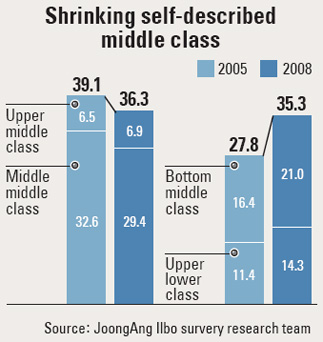Middle-class lives slipping away

Not anymore.
The recent economic downturn, whose impact increasingly resembles the 1997-98 Asian financial crisis, is squeezing hard the lives of many people and pushing families to the edge of poverty.
Now Hwang is afraid that he may soon be forced out of his warm store and onto the cold street, where a former colleague is now collecting scrap iron to support his family.
Saturday night is meant to be the busiest time for Hwang’s business, but at 8 p.m. on Dec. 13, business was anything but roaring.
From 5 p.m. to 8 p.m. he sold only a pair of jeans for 30,000 won ($22), a jacket for 40,000 won and two T-shirts.
Then things really went south. For the rest of the night - until closing time at 4 a.m. Sunday - he did not have a single customer.
“This is what my business is like on a weekend. You can imagine what things are like on weekdays,” said Hwang, stressing that Saturday’s four sales were “better than usual.”
“Some days, absolutely no one comes by, from the moment I open the store to when I close up at night.”
Hwang opened the store in Dongdaemun 10 years ago. He says sales were then quite brisk despite the sweeping economic downturn in the wake of 1997-98 Asian financial crisis. He was able to earn enough cash to buy a 109-square-meter apartment within two years.
“Back then, companies paid huge severance packages to those they fired, so at least there was ample cash everywhere,” Hwang said.
He earned more than 7 million won a month during the crisis, which allowed him to spend well on his child’s education, the ultimate priority for Korean parents.
But things started to tumble this summer. Rising oil prices pushed up the prices of textiles as well, producing unhappy customers who seemed to spend their time examining clothes for hours - clothes that they had no intention of buying. Now he is digging into his ever-dwindling savings to pay for his son’s education and to put food on the table. Hwang said he is afraid he may soon be unable to pay rent for the store and be forced out.
He pointed toward vacant areas in the shopping arcade. Hwang said the work of his former colleague, the one who has since left to collect scrap iron, is often more lucrative than sitting idly at the clothing store.
“At this age, I may be able to do just that once I’m forced out of here,” he said. “I’m no longer in the middle class. I won’t be able to get even a tiny apartment in the city outskirts once I’m pushed out of here.”
But Hwang’s story is hardly anecdotal these days. A growing number of Koreans say they are no longer in the middle class, expressing fears that their once-secure lifestyle may soon be an unaffordable luxury as their situation rapidly deteriorates into poverty.
According to a recent JoongAng Ilbo survey of 880 adults across the country, 1 percent of respondents said they consider themselves upper class, followed by 57 percent for middle class and 42 percent for lower. Each of the three segments was also divided into three tiers.
The results showed 36.3 percent of respondents considered themselves upper-middle class or middle-middle class, lower than the 39.1 percent who saw themselves in that category in a similar 2005 survey.
The results also showed that more people today anxiously see themselves sitting on the thin line between the middle class and poverty. Some 35.3 percent of the respondents in the 2008 survey said they belong to the lower-middle class or higher-lower class, a significant jump from the 27.8 percent who saw themselves like this three years ago.
“The results show the number of ‘middle-class people on the border,’ who feel extremely insecure about their livelihoods, has been rapidly rising for the past three years,” said Kim Mun-cho, a sociology professor at Korea University. “It also means the national drive for growth is crumbling.”
The latest survey also revealed several dangerous signs in Koreans’ insecure thoughts about their futures. For instance, the respondents cited inflation, job insecurity, family health and children’s education as the top four major issues in their lives, respectively.
“Children’s education has always been the top priority in Korea,” said Kim. “The fact that education is behind other factors in the recent survey tells a lot. The sweeping economic troubles are even curtailing desire for upward mobility through education.”
By Special reporting team JoongAng Ilbo/ Jung Ha-won Staff Reporter [hawon@joongang.co.kr]










with the Korea JoongAng Daily
To write comments, please log in to one of the accounts.
Standards Board Policy (0/250자)